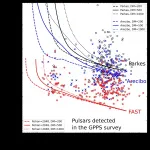(Press-News.org) Normally, mountain forests are among the most diverse habitats in alpine regions. Yet, as a team from the Alfred Wegener Institute discovered in the Tibetan Plateau, the higher, treeless areas are home to far more species. Their findings, which were just published in the journal Nature Communications, can help to predict how the biodiversity of alpine regions will decline in response to global warming - when the mountain forests spread to higher elevations.
As anyone who has ever hiked in the mountains knows, the landscape changes with the elevation. At first, for a long time, you trek uphill through forests, until they open up into the first meadows and pastures, where a wide range of plant species bloom in the spring. Farther up, the landscape becomes more barren. Only those plants that have adapted to the alpine climate can thrive here. In order to map the vegetation of the alpine world, biologists most often investigate plant diversity along so-called elevation levels. First they examine the plants in the sprawling forests, then in the alpine meadows, and then in the rocky upper reaches. No matter where researchers do so - in the Alps, the Caucasus or the Rocky Mountains - the results are always similar: the extensive forests are the most species-rich region. With increasing elevation, biodiversity steadily declines.
More species in treeless areas
A team led by biologist Prof Ulrike Herzschuh from the Alfred Wegener Institute, Helmholtz Centre for Polar and Marine Research (AWI) in Potsdam has now concluded that this thesis isn't necessarily correct: forests by no means have to be the most diverse part of alpine regions. If the evolution of mountain ranges in the course of millennia is considered, it becomes clear that the landscape above the treeline contains many more species than the mountain forests. As Herzschuh and her colleagues report in the journal Nature Communications, they succeeded in reconstructing the evolution of plant diversity in the Tibetan Plateau over the past 17,000 years. What they found: when, in colder phases, the forests retreated to lower regions and the treeline followed suit, the alpine meadows and alpine landscape grew - and with them, the number of species. In warmer phases, the forests spread higher, and the number of species declined. "If we assume the same size, there are more species in the treeless higher areas than in the forests," says Herzschuh. "This also came as a surprise to us, since conventional studies, which always reflect the elevation levels, have always indicated just the opposite."
Broader range of habitats
The study's authors don't yet have a definitive explanation for their discovery. "However, it's safe to assume that there are now more species in forest areas because they're more extensive than the more barren areas near mountain peaks," says Sisi Liu, first author of the study and member of the AWI's research section Polar Terrestrial Environmental Systems. As a result, today there is much more forest available, which can contain various types of habitat, like glades and forest streams. If the alpine areas were larger instead, so Liu and her colleagues surmise, the result would be far more diverse habitats than those found in the forests - shady-moist and sunny-dry areas or sparsely vegetated, nutrient-poor areas and loamy soils - and therefore, a wide range of settings for diverse flora.
Ancient sediments from a Tibetan alpine lake
The southeast Tibetan Plateau is one of the most species-rich mountainous regions in the world, and a so-called biodiversity hotspot. Further, since the region is at such a high elevation, at the end of the last ice age it was heavily glaciated; it was only with the gradual warming of the planet that the forests reclaimed parts of the Plateau. In order to determine how biodiversity changed with the disappearance and return of the forests, Herzschuh and her team assessed the sediments from an ancient lake in the Hengduan Mountains of eastern Tibet. Since the lake was formed after the last ice age, sand, dust and plant remains had gathered there for over 17,000 years. The researchers extracted ancient fragments of DNA strands from the sediments, allowing them to identify which plants lived there at which times. They then combined these biological findings with analyses provided by a mathematical ice model, which can be used to reconstruct the glaciers' changing positions. According to Herzschuh: "With the aid of an ice model developed by our colleagues at the German Research Centre for Geosciences in Potsdam, we were able to precisely trace how the plant community changed with the elevation of the glacier and the shifting treeline."
More forest means less diversity
Interestingly, ca. 8,000 years ago there was a warm phase in which the forests 'migrated' farther uphill than today - and the number of species to be found in the sediment record declined significantly. The findings gleaned by Herzschuh, her PhD candidate Sisi Liu and other colleagues are important in terms of our ability to predict how the biodiversity of mountainous regions around the world could be impacted by climate change; what they learned about the situation in Tibet can also be applied to other alpine regions. "Our data could potentially help to develop new management strategies for combatting the loss of diversity," says Herzschuh. In any case, she claims, the stereotypical image of the mountain forest being the most species-rich type of region needs to be critically reconsidered.
INFORMATION:
Original publication:
Sisi Liu, Stefan Kruse, Dirk Scherler, Richard H. Ree, Heike H. Zimmermann, Kathleen R. Stoof-Leichsenring, Laura S. Epp, Steffen Mischke and Ulrike Herzschuh: Sedimentary ancient DNA reveals a threat of warming-induced alpine habitat loss to Tibetan Plateau plant diversity. Nature Communications (2021), DOI: 10.1038/s41467-021-22986-4
Planned missions to return humans to the Moon need to hurry up to avoid hitting one of the busiest periods for extreme space weather, according to scientists conducting the most in-depth ever look at solar storm timing.
Scientists at the University of Reading studied 150 years of space weather data to investigate patterns in the timing of the most extreme events, which can be extremely dangerous to astronauts and satellites, and even disrupt power grids if they arrive at Earth.
The researchers found for the first time that extreme space weather events are more likely to occur early in even-numbered solar cycles, and late in odd-numbered cycles - such as the one just starting. They are also ...
A new paper in JNCI Cancer Spectrum, published by Oxford University Press, indicates that several non-genetic factors--including greater red meat intake, lower educational attainment, and heavier alcohol use--are associated with an increase in colorectal cancer in people under 50.
In the United States, incidence rates of early-onset colorectal cancer have nearly doubled between 1992 and 2013 (from 8.6 to 13.1 per 100,000), with most of this increase due to early-onset cancers of the rectum. Approximately 1 in 10 diagnoses of colorectal cancer in this country occur in people under 50.
Researchers ...
Philadelphia, May 20, 2021 - Research has shown empathy gives healthcare workers the ability to provide appropriate supports and make fewer mistakes. This helps increase patient satisfaction and enhance patient outcomes, resulting in better overall care. In an upcoming issue of the END ...
A newly developed tool will allow scientists to better gauge how centuries of fossil fuel emissions could be skewing the data they collect from marine environments.
Researchers at the University of Alaska Fairbanks led the effort, which created a way for marine scientists to factor into their results the vast amounts of anthropogenic carbon dioxide that are being absorbed by oceans. Those human-caused carbon sources can muddy research results -- a problem known as the Suess effect -- leading to flawed conclusions about the health and productivity of marine ecosystems.
"The ...
Oncotarget published "Analytic validation and clinical utilization of the comprehensive genomic profiling test, GEM ExTra®" which reported that the authors developed and analytically validated a comprehensive genomic profiling assay, GEM ExTra, for patients with advanced solid tumors that uses Next Generation Sequencing to characterize whole exomes employing a paired tumor-normal subtraction methodology.
The assay detects single nucleotide variants, indels, focal copy number alterations, TERT promoter region, as well as tumor mutation burden and microsatellite instability status.
Additionally, the assay incorporates ...
Scientists have made a major breakthrough in the study of embryonic development and how it can be impacted by external factors such as climate change.
Researchers at the University of Plymouth have developed a cutting edge technique which enables them to instantly examine the biological traits and behaviours of developing embryos as an energy signature, rather than focusing on individual characteristics.
The method, outlined in a study published in BMC Bioinformatics, is built around timelapse video captured by the researchers of aquatic animals - specifically, the embryos of a freshwater pond snail Radix ...
Using the Five-hundred-meter Aperture Spherical radio Telescope (FAST), a research team led by Prof. HAN Jinlin from National Astronomical Observatories of Chinese Academy of Sciences (NAOC) has discovered 201 pulsars, including many very faint pulsars, 40 millisecond pulsars (MSPs), and 16 pulsars in binaries.
These discoveries were published in Research in Astronomy and Astrophysics.
Pulsars are compact remnants of the death of bright, massive stars. They have the strongest magnetic field, highest density and fastest rotation of any celestial body in the Universe, and show significant ...
Nearly two thirds (61%) expressed concern about their worsening mood in Lockdown and associated restrictions1.
34% said they felt more anxious and 28% felt more depressed during Lockdown and associated restrictions1.
Coffee helped lift nearly half (44%) of adult's negative moods in Lockdown and associated restrictions1.
A new pan-European survey funded by the Institute for Scientific Information on Coffee exploring the impact of COVID-19 Lockdowns and associated restrictions (in those countries where there has been no Lockdown), has found that nearly two thirds of adults (61%) expressed concern about their worsening mood; two times higher than those concerned about physical inactivity (24%)1.
Understanding the effects of COVID-19 restrictions ...
Scientists from Hokkaido University have shown that an antigen-based test for quantifying SARS-CoV-2 in saliva samples is simple, rapid, and more conducive for mass-screening.
More than a year into the COVID-19 pandemic, the RT-PCR test remains the gold standard for detection of the SARS-CoV-2 virus. This method requires trained personnel at every step, from collection of nasopharyngeal swab (NPS) samples to interpretation of the results; in addition, the entire process ranges from 24-48 hours on average. As the virus can be transmitted by an infected person before symptoms ...
Fixed-dose combination of nivolumab and relatlimab holds the cancer in check significantly longer than nivolumab alone
This is the first regimen to demonstrate a statistical benefit over anti-PD-1 monotherapy in metastatic melanoma
BOSTON - A combination of two drugs that target different proteins on immune system T cells kept advanced melanoma in check significantly longer than one of the drugs alone in a phase 3 clinical trial involving 714 patients. Dana-Farber Cancer Institute investigators co-led the study. Findings will be presented at the American Society of Clinical Oncology (ASCO) Annual Meeting, being held ...


